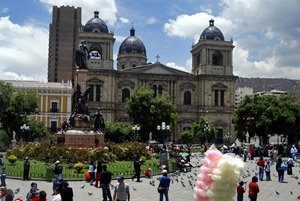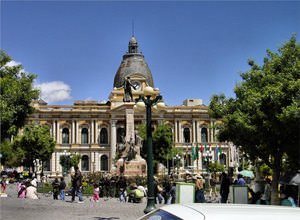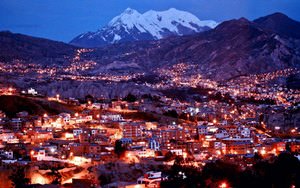
Bolivians are very careful about their history and religion. The conquest of this country by Spain had a great impact. But it did not destroy the memory of the ancient gods. Catholic holidays are organically intertwined with the worship of Inca Gods. Only in this way the Spanish conquistadors manage to introduce a new religion to the country. Modern inhabitants of the country exist organically in this unique fusion of beliefs and prejudices.
Bolivia is a country located in the center of South America. This is the highest country in the world. The country can be divided into three zones, …
Read further
Bolivia is famous for a great variety of carnivals like all Latin American countries. The most famous carnival takes place in the city of Oruro in the first days of February every year. Folklore traditions are unique. They are protected by UNESCO as the "spiritual heritage of humanity". The tradition of worshipping the mother goddess Pachamama and the mountain God Tio Supaya is about 2 thousand years old. The Spaniards never managed to eradicate this holiday. So they gradually convinced the locals that their goddess is the Virgin Mary, and the terrible mountain God is the Devil. An incredibly colorful carnival procession passes through the streets of the city in a strikingly organic symbiosis of cultures. About 400 thousand people come from all over the country and abroad to watch and participate in the carnival. It is held at the same time as the carnival in Brazil. The Bolivian carnival is not inferior to it. The simultaneous performance of more than 30 thousand dancers and up to 10 thousand musicians is the pinnacle of the celebration. They are dressed in national, religious, fantastic, and simply very bright costumes. Local spirits are drunk everywhere during the celebration. This only increases the festive mood. Viewers can join participants at any time. This makes Oruro a single huge carnival. Two mandatory performances are arranged at the end of the celebration. One of them tells about the conquest of these lands by the Spaniards. The second performance is about how the Archangel Michael defeated the Devil.
The Day of Skulls is a traditional celebration of Bolivians. It is held on November 9 every year. It comes as a shock for the uninitiated to see real human skulls in the hands of people. Local people pay tribute to their ancestors in this way. Bones decorated with wreaths of flowers are taken out to the streets. Small gifts are presented to them. Locals walk with them. Pre-Columbian Inca beliefs were mixed with the celebration of the Catholic Day of the Dead (the day of remembrance of all the dead). This is an incredible mixture of the fear of death and the joy of life. The ancient inhabitants of the Andes believed that man has 7 souls. One of them stays in his bones. Therefore, it is customary to dig up the deceased people after three years to take the skull and take care of it. It is believed that this will save a person from any troubles and save the family. Copyright www.orangesmile.com
These spots really worth the attention of a real traveler-researcher.
…
Read further
All Saints' Day is celebrated on the first of November. It's a Catholic holiday. The Spanish did not succeed in completely destroying the beliefs of the local population. Traditions of worship of Injun Gods have also been preserved. The holiday marks the beginning of the rebirth of nature in spring. The souls of the dead return to earth on this day. Therefore, it is customary to go to cemeteries to treat and entertain them. This is happy but not a sad holiday.
![The Legislative Palace, La Paz The Legislative Palace, La Paz]()
The Fiesta Virgen de la Candelaria is most widely celebrated in Copacabana. It is a small town located near Lake Titicaca. The main events of the celebration take place on February 2. Numerous pilgrims from all over the country gather in the streets on this day. Songs, dances, and fun last all day long. The participants of the celebration praise the main patron Saint of the country this way. The mix of traditional Injun and Catholic customs gives a unique flavor and attracts many tourists.
During its centuries old history, Bolivia has become home to many places of interest and historic landmarks that are known far beyond the borders of …
Read further
The Chiquitos music festival is the largest regional cultural festival in the country. It is held in early May every two years. Residents of Chiquitos Province are considered the poorest in the country. They were converted to Catholicism through training in crafts and music during the Spanish colonization. The Catholic missions and churches under them had magnificent orchestras made up of local residents who were surprisingly musical. Introduced and the national arts have been harmoniously combined. The result is a perfect example of the interpenetration of cultures. The world got a great classical music festival. It is considered one of the most famous in the world. Many performers are proud to participate in it.
![]()
The Fiesta del Gran Poder dates back to the first half of the last century. It is celebrated mainly in the city of La Paz. This is one of the largest and most popular street festivals in the capitals of the world today. The celebration is dedicated to Jesus Christ. His large figure is carried at the beginning of the carnival procession. It is a tradition throughout Latin America to carry huge statues of saints on parades. The celebration is traditionally held at the end of May every year. You can see an unimaginably bright mix of clothes, masks, and dancing in the streets. Marinada is the most spectacular. It combines the musical traditions of Injuns and black slaves brought here.
The state of Bolivia is located in the central part of South America. Most of it is located in the highlands of the Andes. The complex geographical …
Read further
Inti Raymi is held in early June across the country. This holiday was dedicated to the great Sun God – Inti. It was one of the most important holidays 500 years ago. Animals are sacrificed on this day to earn the mercy and help of God in agriculture. Enthusiasts began a gradual revival of the ancient ritual about 70 years ago, despite the fact that there are no great Incas for many centuries and the last such festival was held in 1535. It is most widely celebrated in Peru. But this holiday counts more and more supporters every year also in Bolivia.
 Bolivians are very careful about their history and religion. The conquest of this country by Spain had a great impact. But it did not destroy the memory of the ancient gods. Catholic holidays are organically intertwined with the worship of Inca Gods. Only in this way the Spanish conquistadors manage to introduce a new religion to the country. Modern inhabitants of the country exist organically in this unique fusion of beliefs and prejudices.
Bolivians are very careful about their history and religion. The conquest of this country by Spain had a great impact. But it did not destroy the memory of the ancient gods. Catholic holidays are organically intertwined with the worship of Inca Gods. Only in this way the Spanish conquistadors manage to introduce a new religion to the country. Modern inhabitants of the country exist organically in this unique fusion of beliefs and prejudices.
 The Fiesta Virgen de la Candelaria is most widely celebrated in Copacabana. It is a small town located near Lake Titicaca. The main events of the celebration take place on February 2. Numerous pilgrims from all over the country gather in the streets on this day. Songs, dances, and fun last all day long. The participants of the celebration praise the main patron Saint of the country this way. The mix of traditional Injun and Catholic customs gives a unique flavor and attracts many tourists.
The Fiesta Virgen de la Candelaria is most widely celebrated in Copacabana. It is a small town located near Lake Titicaca. The main events of the celebration take place on February 2. Numerous pilgrims from all over the country gather in the streets on this day. Songs, dances, and fun last all day long. The participants of the celebration praise the main patron Saint of the country this way. The mix of traditional Injun and Catholic customs gives a unique flavor and attracts many tourists.
 The Fiesta del Gran Poder dates back to the first half of the last century. It is celebrated mainly in the city of La Paz. This is one of the largest and most popular street festivals in the capitals of the world today. The celebration is dedicated to Jesus Christ. His large figure is carried at the beginning of the carnival procession. It is a tradition throughout Latin America to carry huge statues of saints on parades. The celebration is traditionally held at the end of May every year. You can see an unimaginably bright mix of clothes, masks, and dancing in the streets. Marinada is the most spectacular. It combines the musical traditions of Injuns and black slaves brought here.
The Fiesta del Gran Poder dates back to the first half of the last century. It is celebrated mainly in the city of La Paz. This is one of the largest and most popular street festivals in the capitals of the world today. The celebration is dedicated to Jesus Christ. His large figure is carried at the beginning of the carnival procession. It is a tradition throughout Latin America to carry huge statues of saints on parades. The celebration is traditionally held at the end of May every year. You can see an unimaginably bright mix of clothes, masks, and dancing in the streets. Marinada is the most spectacular. It combines the musical traditions of Injuns and black slaves brought here.


